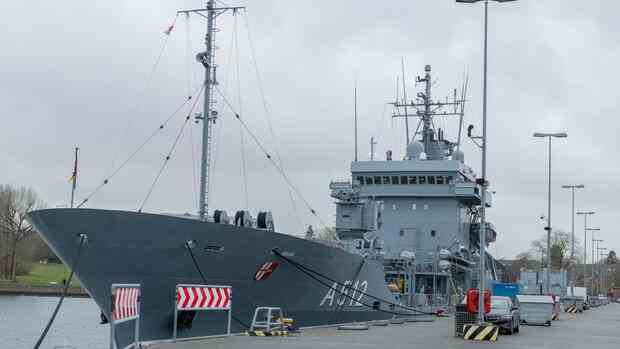keel If an enemy ship is in sight, the Bundeswehr often reaches for the felt pen. On the supply ship Tender Mosel, for example, the soldiers then have to place a nautical chart behind Plexiglas, mark the enemy’s position and wipe it off from time to time and draw it a few centimeters further on.
Frigate captain Volker Voss, who works with the naval support command, hasn’t been able to stand by for ten years. He has observed similar things with other types of Bundeswehr ships. “The command weapon deployment systems all had their problems,” says Voss.
Because he didn’t expect any improvement, he started programming – a software that could not only digitize the ship tender, but also other ships and systems. That might help that To make the Bundeswehr more independent from industry and more flexible.
But just because someone in the Bundeswehr has a good idea doesn’t mean they can implement it. Nils Hoffmann describes this as a “dilemma of large organizations”. He is the managing director of the company Public, das advises the public sector on digitization projects.
Everyone has a clear role in the Bundeswehr. Direct managers often recognize when an employee can make a greater contribution with their own ideas than with their original tasks. But: They should also be able to make that clear to their own superiors. “If you don’t have particularly good contacts at the top of an organization, it becomes very difficult.”
Operating system for warships? Voss was lucky that he was allowed to start
Voss was lucky. He met superiors who let him experiment and also brought him together with the Bundeswehr’s Cyber Innovation Hub (CHIB). This was set up six years ago to advance the digitization of the Bundeswehr and to help servicewomen and men to take innovation projects into their own hands.
“We are looking for the Bill Gates of the Bundeswehr,” says head Sven Weizenegger. Just as the founder of Microsoft changed the computer world with his visions, the same can be said of the Bundeswehr.
They called Volker Voß’s project and his experiment on the tender “Tesla Tender” – in reference to Elon Musk’s car company.
The frigate captain works for the naval support command – and over the years has developed a kind of operating system for naval ships.
(Photo: Bundeswehr / Tom Twardy)
The CHIB is allowed to provide entrepreneurial coaching to members of the Bundeswehr, to experiment with them, to provide money from a budget of ten million and to propose their developments for procurement. That could now also be the next step with “Mese”, the system that Voss came up with.
You can think of Mese as something like Android. Just as the cell phone operating system runs on various end devices, Mese can be used on tenders, warships of the corvette or frigate type and speedboats.
At the same time, the crew can integrate different functionalities depending on their needs, comparable to smartphone apps. One of these functionalities is the situational image display, which can automatically include data from cameras and radars.
Commander wants to see where the enemy might show up – and gets the job in two days
Together with the crew of the Tender Mosel and the CIHB, Voss tested the system on the high seas at the end of January. Instead of “analyzing code in a defense technology department”, the Cyber Innovation Hub relies on quickly trying out developments with the end users, says CHIB innovation manager Jan Philipp Krahn.
>> Read also: Thyssen-Krupp Marine Systems wants to restart with stealth submarines
One of these end users is tender commander Stefan Ladewich. During the test, he wanted to know whether the situational picture could also show how far an enemy that had already been sighted could travel within a certain time and where he could turn up.
The Mese system brings together the most important sensor data in one display and helps the crew to keep an eye on the situation.
(Photo: Bundeswehr / Tom Twardy)
After a few days he got the simulation function, says Ladewich. “I see it as a great advantage that we have a system in the Navy that we can make improvements to ourselves.”
Less dependent on industry, be up and running faster
With solutions from the industry, change requests cannot be implemented so quickly. That’s why CHIB director Weizenegger is also campaigning for the Bundeswehr to get more of its own source code: “If the picture of the situation changes and we need new functionality in a week, then we would be able to develop it ourselves.”
Today, ships from different manufacturers often cannot communicate with each other because they build closed systems. With an open infrastructure, as in the case of Mese, all companies could dock their solutions.
This is how the crew of the tender supply ships create their situation maps to this day. They have to take the data from different systems.
(Photo: Bundeswehr / Tom Twardy)
Developer Voss goes even further and advocates a “weapons-independent infrastructure”. In principle, Mese can also be used in land and air systems and ensure that all soldiers have the same user interface.
The Bundeswehr Procurement Office must now decide how to proceed with Mese. For the time being, however, the Navy is likely to continue using its first system – perhaps even in the Mediterranean, where the Bundeswehr is supposed to be on the lookout for smugglers in the NATO support mission.
Commander Ladewich says: “Personally, I would have no problem taking the whole situational awareness system as it is and giving it to the comrade who is going to the Aegean next week.”
More: “Ghostplay” – This AI should make the Bundeswehr better
